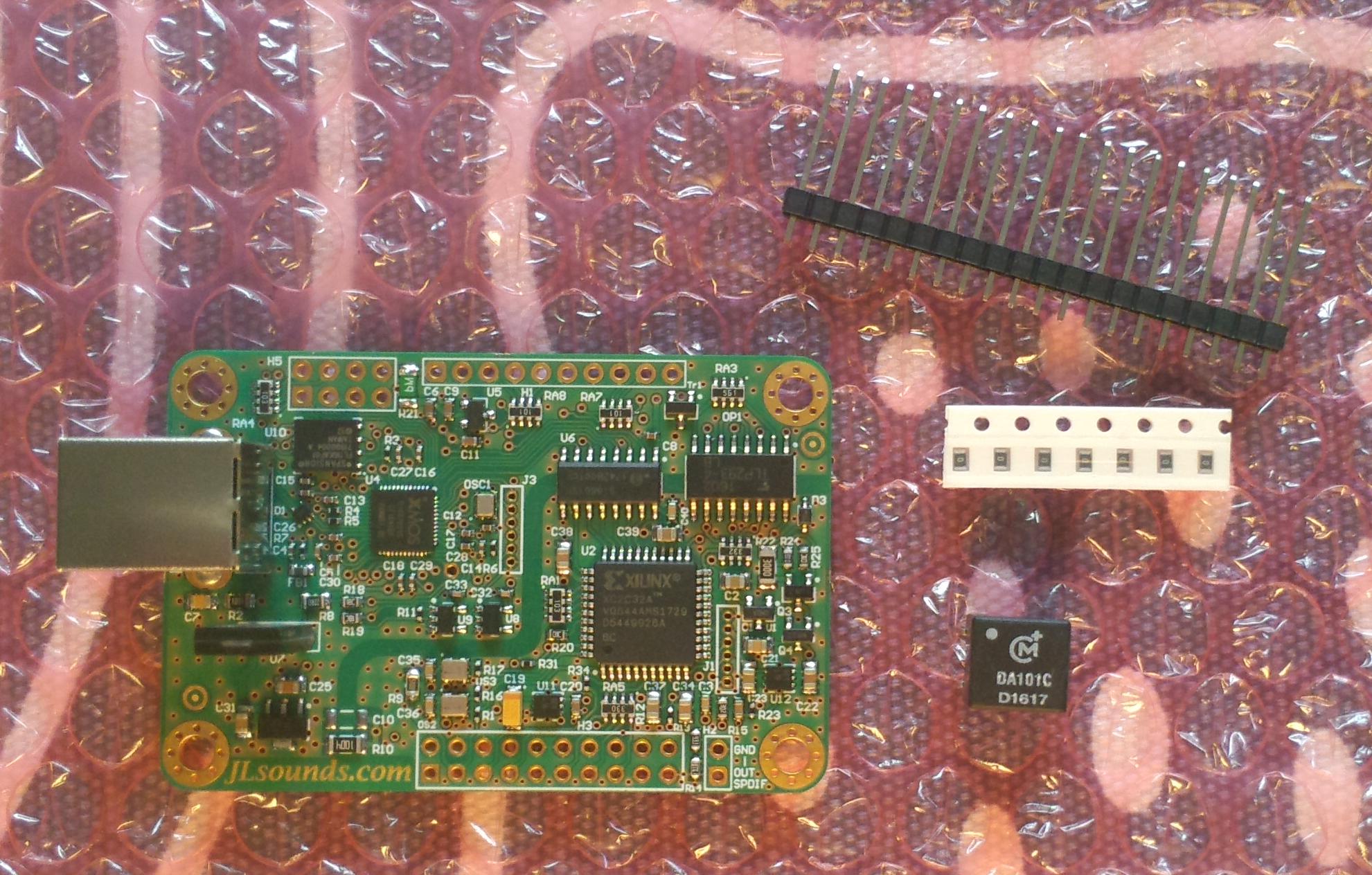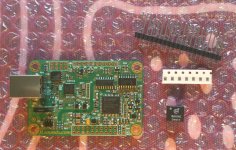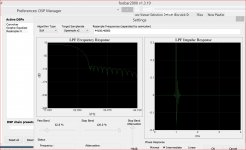One of the problem is that he only has 3 pieces.
For balanced one needs 4 pieces.
Even if someone would build SE, there is one to spare.
What a waste it would be ......
Patrick
I regularly purchase a spare unit of an component which I suspect may not be readily available, or more expensive, in the future. That third chip may have been purchased as a spare simply as insurance in case of an future failure.
I can't really remember why I bought 3, probably doubting my solder skills...
What I do remember is I bought a ESI Julia PCI soundcard to feed them I2S, remember PCI ? 😀
Problem was, the AKM(?) DAC in the Julia wasn't half bad - so the project died.
What I do remember is I bought a ESI Julia PCI soundcard to feed them I2S, remember PCI ? 😀
Problem was, the AKM(?) DAC in the Julia wasn't half bad - so the project died.
Ordered the USB->I2S converter from JLsounds.
If I read the description correct it can drive 2 1704's directly without glue-logic.
Then it's 'just' the small matter of designing a PCB....this is going to take a while.
Remodeling the kitchen is slowly moving to the top of the queue 🙁
If I read the description correct it can drive 2 1704's directly without glue-logic.
Then it's 'just' the small matter of designing a PCB....this is going to take a while.
Remodeling the kitchen is slowly moving to the top of the queue 🙁
do not create gifts on this forum, from my experience, everything ends up in a drawer, or on ebay, motivation often ends on free items 😀
jlsounds board is good choice for 1704,
the very important is I/V stage, do not hestitate try standard opamp I/V with good sounding opamp in I/V (ADA4898-1, LM6171, LTC6090, OPA1688, LME49990, OPA1641, experiment with AD844) ... avoid passive I/V
do not forget for well routed PCB, where digital is not mixed with analog and solid ground is used
jlsounds board is good choice for 1704,
the very important is I/V stage, do not hestitate try standard opamp I/V with good sounding opamp in I/V (ADA4898-1, LM6171, LTC6090, OPA1688, LME49990, OPA1641, experiment with AD844) ... avoid passive I/V
do not forget for well routed PCB, where digital is not mixed with analog and solid ground is used
Last edited:
...everything ends up in a drawer...
Yeah, I know 😀
EUVL convinced me to resurrect the project again, we'll see how long my steam last this time.
I've got some urgent renovation to be done in the house, so less time for fun 🙄
I guess I better edit the first post..
perfect 🙂
my PCM1704 DAC is based on the simpliest possible design, with 16b/44kHz ...
https://ctrlv.cz/shots/2018/07/27/vxdK.png - PCM1704 itself
https://ctrlv.cz/shots/2018/07/27/kPji.png - shift logic
https://ctrlv.cz/shots/2018/07/27/CUFY.png - usb/i2s
https://ctrlv.cz/shots/2018/07/27/Co7M.png - usb powered, isolated DC-DC, simple
I/V is basic opamp based
PCB is 4-layer with solid GND
it is fast the same as my easyDAC with AD1862
my PCM1704 DAC is based on the simpliest possible design, with 16b/44kHz ...
https://ctrlv.cz/shots/2018/07/27/vxdK.png - PCM1704 itself
https://ctrlv.cz/shots/2018/07/27/kPji.png - shift logic
https://ctrlv.cz/shots/2018/07/27/CUFY.png - usb/i2s
https://ctrlv.cz/shots/2018/07/27/Co7M.png - usb powered, isolated DC-DC, simple
I/V is basic opamp based
PCB is 4-layer with solid GND
it is fast the same as my easyDAC with AD1862
...well said jesperHi ... Just FYI the PCM1704 is likely capable of going up to 768 kHz/24 bits or there's a rumour that it will even do 1.536 MHz. This is with no oversampling.
If you decide to use the 1704 for a project - and maybe prefer a simple(r) setup - JLsounds USB-to-I2S directly offers the bit "shuffling" needed to align two channels so that external oversampling filters or electronic circuitry for this is not needed.
I2SoverUSB - I2S over USB Audio
Otherwise no affiliation with JLsounds ;-) ... And I otherwise have no experience with how this "USB" bridge sounds.
Cheers,
Jesper
I would like to draw attention to my personal interpretation of the most appropriate use of the PCM1704 chipDAC. My work has developed using just the JLSounds I2sOverusb USB card that is able to process the i2s signal in the language accepted since 1704 without needing any logical glue (useless with JLSounds). Not to mention the whole process refer to the description made for friends in my Italian forum.
In the mature form of my construction there is a motherboard that connects two mono miniboards that welcome the pcm1704 with the jlsounds. moreover, the IV card based on the OPA861 is used, both for conversion and as a buffer (circuit taken entirely from the P.Rogic project for the AYA DAC). All power supply(six) are currently based on the LT3045 (Ivanov boards).....previously salas shunt.....and previously others shunt
How does it sound? Really very good both for me and for many friends who wanted to replicate it.
PS..... my nick in italian forum is bigtube
Last edited:
Thank you miro1360 and sontero.
When ordering from JLSounds, did any of you get an 'order confirmation' ?
I've only got the paypal receipt...maybe he is on vacation, it's not like I'm in a rush 😀
I couldn't access the nexthardware forum, so I had to fire up a windows box 🙄
...but my word, that is a ambitious project 😱
Lots of info, will take a while to digest - Thanks again.
When ordering from JLSounds, did any of you get an 'order confirmation' ?
I've only got the paypal receipt...maybe he is on vacation, it's not like I'm in a rush 😀
I couldn't access the nexthardware forum, so I had to fire up a windows box 🙄
...but my word, that is a ambitious project 😱
Lots of info, will take a while to digest - Thanks again.
Thank you miro1360 and sontero.
When ordering from JLSounds, did any of you get an 'order confirmation' ?
I've only got the paypal receipt...maybe he is on vacation, it's not like I'm in a rush 😀
I couldn't access the nexthardware forum, so I had to fire up a windows box 🙄
...but my word, that is a ambitious project 😱
Lots of info, will take a while to digest - Thanks again.
You might want to take a look at my project with CM6631A and an FPGA:
http://www.diyaudio.com/forums/digi...m6631-usb-audio-interface-70.html#post5470041
You can connect it directly to 2 PCM1704 for single ended output or 4 PCM1704 for differential output with a maximum data flow of 768 kHz. PCM1704 does support data flow of up to 768 kHz without any issues, but you need a hardware to handle that kind of data flow from the computer (and my project does that).
Any kind of glue logic isn't required. You do set the output length by using two jumpers (from 16-bit to 24-bit for PCM1704).
It's even possible to run TDA1541(A) at 384 kHz or PCM56 at 768 kHz. That is without any additional logic. The possibilities are endless 🙂
Hey, that's impressive stuff.
I'll try to keep it as simple as possible to begin with, the JLSounds interface looks simple enough.
Good to know there are projects still around with the 1704 in mind. 🙂
I'll try to keep it as simple as possible to begin with, the JLSounds interface looks simple enough.
Good to know there are projects still around with the 1704 in mind. 🙂
Got my USB interface from JLsounds.
Seems there are a new version out...but so far only preliminary documentation 🙄
No big deal though, the pins I need are the same as on the old board.

SPDIF transf, config resistors and headers were included - although there's no place to mount the trafo...good thing I don't need it 😀
Seems there are a new version out...but so far only preliminary documentation 🙄
No big deal though, the pins I need are the same as on the old board.
SPDIF transf, config resistors and headers were included - although there's no place to mount the trafo...good thing I don't need it 😀
Attachments
I think he´s right. Good thing is we don´t need digital filters to get the best from our old dac chips. I upsample in JRiver with this option enabled: "Use SoX for resampling". In my opinion SoX sounds better than the standard resampler.Dan Lavry made a case for over-sampling benefits to max out about 90kHz with R2R chips so why go faster?
You also need dithering after any operation done in the digital domain, so I use this VST plugin: NotJustAnotherCD. Better than the built in dither. But this is for 16 bit output only.
-Alex
It is definitely a good idea. I have experience with a few dac chips: AD1865, TDA1543, 1545, 1387.So is the stop clock thing a good idea or propaganda?
Actually, the only one I have compared with and without stopped clock is the TDA1543. The difference is not small. I was not a believer and yet I heard a difference for the better. I had thought it wouldn´t be a problem to leave the bitclock operating continously, but since ECDesigns has emphasized the importance of these details I decided to try it. He is right.
The AD1865 I have always used with stopped clock, simultaneous operation, simply because it makes the most sense. I use a cpld and a reclocker after the cpld.
I believe the other chips (TDA1545 and TDA1387) need a continous clock for operation (calibration) so I haven´t tried stopped clock with those.
It seems that RF/EMI plays a very important role in SQ.
-Alex
Last edited:
You also need dithering after any operation done in the digital domain, so I use this VST plugin: NotJustAnotherCD.
Dither before, not after, any bit-depth reduction. Also, dither is not required for 'any' operation in the digital domain, only for operations that can produce quantizing noise. The purpose of dither is to replace quantizing noise with random noise instead. If done properly it can preserve maybe a few bits of signal buried in noise below the new LSB. Also, it generally sounds better than quantizing noise.
Mark I assure you I understand perfectly the role of dither in digital audio.
In my case I use digital volume and sample rate conversion inside JRiver. It operates internally with 64 bits precision, therefore dithering is needed to reduce the wordlenght to 16 bits. I have three options: TPDF, Jriver bit-exact or this VST plugin that I found (NotJustAnotherCD), and I can hear differences between them because I don´t use any analog volume control after the dac.
In my case I use digital volume and sample rate conversion inside JRiver. It operates internally with 64 bits precision, therefore dithering is needed to reduce the wordlenght to 16 bits. I have three options: TPDF, Jriver bit-exact or this VST plugin that I found (NotJustAnotherCD), and I can hear differences between them because I don´t use any analog volume control after the dac.
Dither before, not after, any bit-depth reduction. Also, dither is not required for 'any' operation in the digital domain, only for operations that can produce quantizing noise. The purpose of dither is to replace quantizing noise with random noise instead. If done properly it can preserve maybe a few bits of signal buried in noise below the new LSB. Also, it generally sounds better than quantizing noise.
Mark, yes, you are correct of course. I didn´t write it very well. It is not required for 'any' operation in the digital domain.
Just checked my player settings....
I'm using foobar2k with the sox resampler set to 2X and 'high' profile.
So that would mean 88.2k for most of my music...
...but foobar2k outputs to DirectSound, which is configured to 96k (Lindemann USB DAC)😕
Haven't fiddled with this for some time, seems to remember that settings were choosen for convenience.
I never could get foobar/mpc/YT to work in a seamless way over ASIO...
Did some listening test, couldn't really tell any difference.
Will be interesting to compare, if I ever get this project finished 😀
I'm using foobar2k with the sox resampler set to 2X and 'high' profile.
So that would mean 88.2k for most of my music...
...but foobar2k outputs to DirectSound, which is configured to 96k (Lindemann USB DAC)😕
Haven't fiddled with this for some time, seems to remember that settings were choosen for convenience.
I never could get foobar/mpc/YT to work in a seamless way over ASIO...
Did some listening test, couldn't really tell any difference.
Will be interesting to compare, if I ever get this project finished 😀
Can´t SoX resample from 44.1 to 96 KHz? I think it can.
I am going to 88.2 KHz, just because my diy dac is synchronously reclocked and the oscillator is 11.2896 MHz (256 x 44.1 KHz).
BTW, in JRiver you can´t choose modes for SoX but it defaults to what I think is the highest quality. I belive it is: Linear Phase, VHQ, Steep Filter.
Changing subject a bit, I recently watched this short interview with Bernie Grundman, mastering engineer, and I thought some people here might like it. The interviewer is clueless but Bernie gives a few interesting answers for a more technical audience (such as ourselves).
(Think twice before going balanced/differential! Be it the dac, line stage, whatever... Altough, personally, my amp is still differential/push pull.)
YouTube
Thanks
Alex
I am going to 88.2 KHz, just because my diy dac is synchronously reclocked and the oscillator is 11.2896 MHz (256 x 44.1 KHz).
BTW, in JRiver you can´t choose modes for SoX but it defaults to what I think is the highest quality. I belive it is: Linear Phase, VHQ, Steep Filter.
Changing subject a bit, I recently watched this short interview with Bernie Grundman, mastering engineer, and I thought some people here might like it. The interviewer is clueless but Bernie gives a few interesting answers for a more technical audience (such as ourselves).
(Think twice before going balanced/differential! Be it the dac, line stage, whatever... Altough, personally, my amp is still differential/push pull.)
YouTube
Thanks
Alex
Just checked my player settings....
I'm using foobar2k with the sox resampler set to 2X and 'high' profile.....
You might like WASAPI event mode 24 bits output with Resampler-V to use SOX at any rates you want with tailored impulse.
Attachments
Last edited:
- Home
- Source & Line
- Digital Line Level
- Any project with PCM1704

